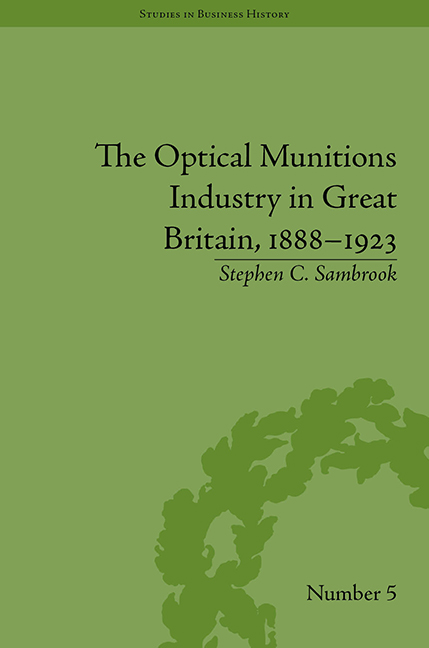Book contents
- Frontmatter
- CONTENTS
- Preface and Acknowledgements
- List of Figures and Tables
- List of Technical Terms
- Introduction
- 1 The Emergence of the Industry, 1888–99
- 2 The Growth in Importance from the Boer War to 1906
- 3 Expansion and Consolidation, 1907–14
- 4 The Impact of War, August 1914 to mid-1915
- 5 Industrial Mobilization: The Ministry of Munitions and its Relationship with the Industry
- 6 The Industry's Wartime, 1915–18
- 7 Industrial Demobilization and Implosion, 1919
- 8 Adaption and Survival, 1919–23
- Conclusion
- Notes
- Works Cited
- Index
Preface and Acknowledgements
- Frontmatter
- CONTENTS
- Preface and Acknowledgements
- List of Figures and Tables
- List of Technical Terms
- Introduction
- 1 The Emergence of the Industry, 1888–99
- 2 The Growth in Importance from the Boer War to 1906
- 3 Expansion and Consolidation, 1907–14
- 4 The Impact of War, August 1914 to mid-1915
- 5 Industrial Mobilization: The Ministry of Munitions and its Relationship with the Industry
- 6 The Industry's Wartime, 1915–18
- 7 Industrial Demobilization and Implosion, 1919
- 8 Adaption and Survival, 1919–23
- Conclusion
- Notes
- Works Cited
- Index
Summary
This book has its somewhat unlikely origins in my longstanding, but for some time dormant, interest in the seemingly disparate technologies of weapons and optical instruments. That interest was reawakened by chance several years ago when a friend gave me a copy of Anthony Pollen's The Great Gunnery Scandal which he thought might make for a good book at bedtime. Telling the story of one inventor's efforts before the First World War to sell the British Admiralty a new system for controlling long-range naval gunnery, it did indeed turn out to be what used to be called a ‘jolly good read’. I owe Michael Grey a good deal of thanks for the gift of the book because it led me to the realization that the two technologies not only converged in the control and deployment of weapons but also had distinct commonalities in the way they were conceptualized, understood, selected and acquired by their military clients. As I began to explore both areas it quickly became apparent that although there was an abundance of literature, both scholarly and popular, on the design and manufacture of weapons, there was virtually nothing on the production of optics for warfare.
Optical munitions have indeed been very much been overlooked by historians of all persuasions, something which was pressed home to me by my then undergraduate supervisor Alan Simmonds. It was he who first encouraged me to investigate the subject and to develop my findings.
- Type
- Chapter
- Information
- The Optical Munitions Industry in Great Britain, 1888–1923 , pp. vii - viiiPublisher: Pickering & ChattoFirst published in: 2014



